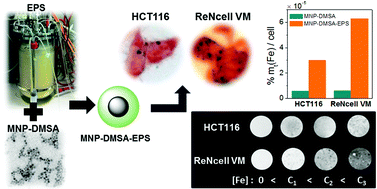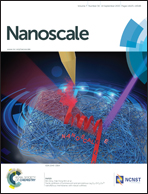A value-added exopolysaccharide as a coating agent for MRI nanoprobes†
Abstract
Fucopol, a fucose-containing exopolysaccharide (EPS) produced by the bacterium Enterobacter A47 DSM 23139 using glycerol as a carbon source, was employed as a new coating material for iron oxide magnetic nanoparticles (MNPs). The coated particles were assessed as nanoprobes for cell labeling by Magnetic Resonance Imaging (MRI). The MNPs were synthesized by a thermal decomposition method and transferred to an aqueous medium by a ligand-exchange reaction with meso-2,3-dimercaptosuccinic acid (DMSA). Covalent binding of EPS to DMSA-stabilized nanoparticles (MNP–DMSA) resulted in a hybrid magnetic–biopolymeric nanosystem (MNP–DMSA–EPS) with a hydrodynamic size of 170 nm, a negative surface charge under physiological conditions and transverse to longitudinal relaxivity ratio, r2/r1, of 148. In vitro studies with two human cell lines (colorectal carcinoma – HCT116 – and neural stem/progenitor cells – ReNcell VM) showed that EPS promotes internalization of nanoparticles in both cell lines. In vitro MRI cell phantoms showed a superior performance of MNP–DMSA–EPS in ReNcell VM, for which the iron dose-dependent MRI signal drop was obtained at relatively low iron concentrations (12–20 μg Fe per ml) and short incubation times. Furthermore, ReNcell VM multipotency was not affected by culture in the presence of MNP–DMSA or MNP–DMSA–EPS for 14 days. Our study suggests that Fucopol-coated MNPs represent useful cell labeling nanoprobes for MRI.



 Please wait while we load your content...
Please wait while we load your content...